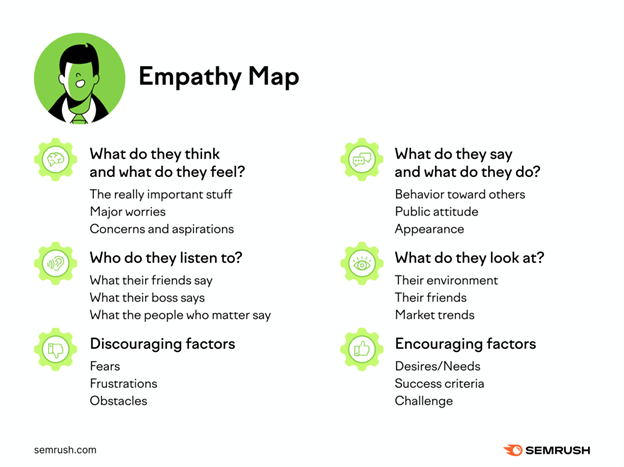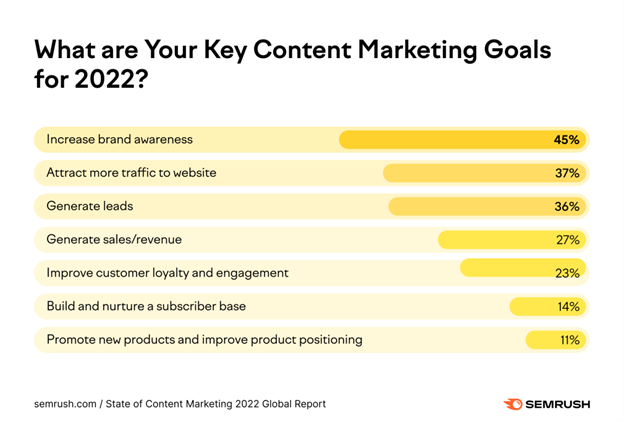Looking for this year’s keys to help you build your next content marketing strategy?
Wish you had a powerful content roadmap to help your business reach new heights in 2023?
Wondering what other content marketers have that you may be missing?
According to Semrush’s State of Content Marketing 2022 Report, 78% of marketers who believed their content marketing generated positive results had a documented content strategy.
So, how do you configure the right strategy to truly beat your competition?
The key to a successful content marketing strategy is to follow this ultimate content marketing checklist:
- Build buyer personas; explore your audience and find their pain points. This will help you become the most helpful resource on the web.
- Establish your brand story and make it shine through your future content.
- Set measurable content goals for the year.
- Run a content audit to find gaps in your existing inventory.
- Discover the topics your audience cares about the most.
- Optimize your content not only for the readers but also for search engines to gain more visibility.
- Pick the best content distribution channels.
- Use tools and templates to automate each step of the process.
This article will show you the steps to create an effective content marketing strategy and action plan, plus tell you the tools you’ll need along the way.
Develop Audience Personas With Buyer Persona Templates
Tool You’ll Need:
Who, exactly, are you targeting with your content?
What are goals they are struggling with that your content can help them achieve?
Without a solid understanding of who you’re targeting, it can be very difficult to discover what topics to cover and what content to create.
Without a clear audience in mind, you can’t create solution-oriented content, and you won’t have a clear, easy-to-formulate content plan.
Luckily, by uncovering who your target audience is with persona templates, you’ll be led straight to the ideal content for your audience.
These templates walk you through the process of defining your personas:
- Pain points.
- Motivations.
- Demographics.
- Preferred channels.
- Top influencers, and much more.
Once you know their pain points and can connect to your audience with true empathy, it’s easy to create helpful content that answers popular questions and offers solutions.
 Image created by Semrush, October 2022
Image created by Semrush, October 2022Establish Your Brand Story With Template Kits
Tool You’ll Need:
If you want your content to provide a correct and consistent image for your brand, you need to establish your brand story first.
You can glean valuable insight by examining your brand’s:
- Customers.
- Competitors.
- Unique value proposition in your market.
To establish your brand story, use this six-step storytelling template.
Use this as the element of your content strategy that allows you to build deeper connections with readers and customers.
Define Your Content Value Proposition & Mission Statement
Why should readers choose your content over your competitor’s?
What unique value does your content have that will encourage readers to finish articles, subscribe to your email list, and follow your brand?
Use the answers to these questions to define your content value proposition and formulate your content marketing mission statement.
The process of building your mission statement should include identifying your target audience and their goals, plus how your content will help the audience achieve those goals.
While I don’t have any tools for this purpose, I suggest using the following mission statements as examples to base yours on:
- “Educating and empowering the SEO community by providing the freshest news and latest best practices via the industry’s smartest practitioners.” (Search Engine Journal)
- “Our content is where digital marketing managers find multimedia information about SEO and content marketing so that they can help their companies grow via organic channels.” (Semrush)
Set Your Content Marketing Goals
Guide You’ll Need:
What goals do you expect your content to achieve to make a positive impact on your company’s bottom line?
Setting specific goals will allow you to determine if your content marketing strategy is serving its purpose.
According to 40+ marketers surveyed, the top content marketing goals are an increase in brand awareness, website traffic, and lead generation.
 Image created by Semrush, October 2022
Image created by Semrush, October 2022As you set goals for your content marketing strategy, use your company’s website analytics and social media insights tools. Determine if your content has had an impact on your metrics, and if so, by how much.
This will give you a baseline to work with as you prepare goals moving forward for your content strategy to measurably achieve specific key performance indicators (KPIs) and objectives and key results (OKRs).
Project management tools like Asana have goal-setting features within their product.
Sharing goals across the company allows everyone to know how their work applies to helping the company achieve business results.
Inventory Your Current Content Library
Tools You’ll Need:
You can’t complete a library without taking stock of what you have in your current inventory. A content audit allows you to see what content you have, exposing areas for optimization and improvement.
65% of the marketers who considered their content marketing efforts extremely successful ran content audits at least twice a year.
Of course, if you have a large website, auditing your content can be a tedious task. Fortunately, you can use a content audit tool to automate the process.
Using real-time metrics from Semrush, Google Analytics, and Google Search Console, the content audit tool will inspect your website’s folders and subfolders to reveal content that needs to be improved upon, rewritten, or removed to improve your overall content quality.
"strategy" - Google News
November 07, 2022 at 03:45PM
https://ift.tt/xrznyUQ
12 Ultimate Tools & Tactics For Effective Content Strategies In 2023 - Search Engine Journal
"strategy" - Google News
https://ift.tt/AukxvcL
https://ift.tt/mXjRaAw
Bagikan Berita Ini














0 Response to "12 Ultimate Tools & Tactics For Effective Content Strategies In 2023 - Search Engine Journal"
Post a Comment